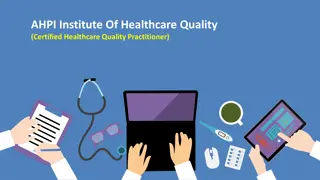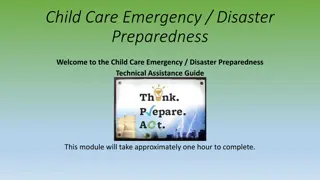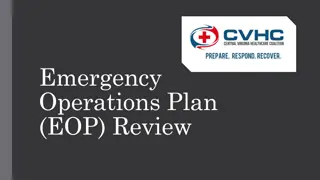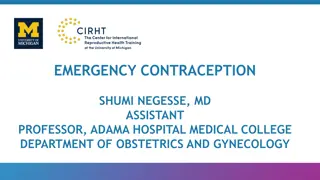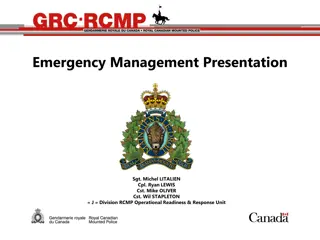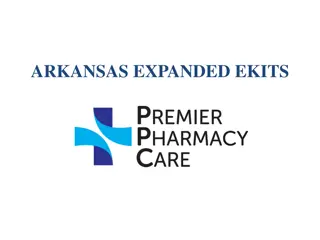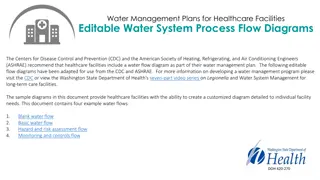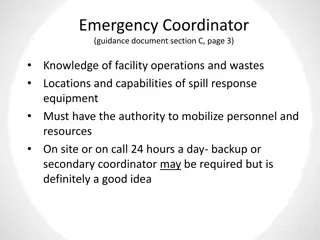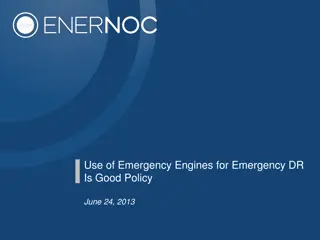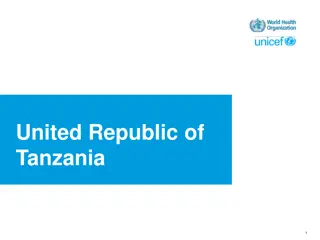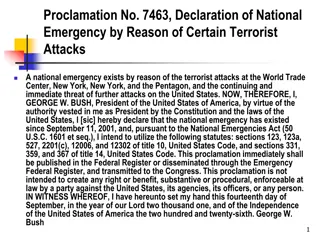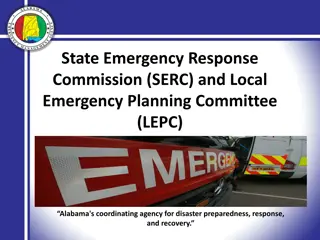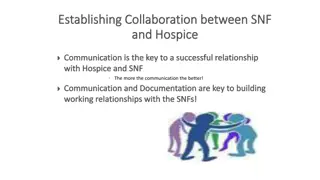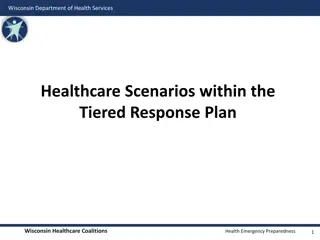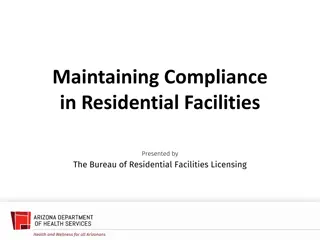Comprehensive Emergency Management in Healthcare Facilities
In the healthcare setting, having a robust Emergency Operations Plan (EOP) is crucial for addressing various disruptions and disasters effectively. This plan outlines coordination with other facilities and the community, communication strategies, mitigation efforts, command structure, staffing arrangements, patient tracking, and more. Healthcare facilities must adhere to regulations set by agencies like CMS, TJC, NFPA, and OSHA to ensure preparedness for emergencies.
Download Presentation

Please find below an Image/Link to download the presentation.
The content on the website is provided AS IS for your information and personal use only. It may not be sold, licensed, or shared on other websites without obtaining consent from the author. Download presentation by click this link. If you encounter any issues during the download, it is possible that the publisher has removed the file from their server.
E N D
Presentation Transcript
St. Marys Hospital Medical Center St. Vincent Hospital St. Nicholas Hospital St. Clare Hospital St. Clare Rural Healthcare Clinics
At the conclusion of this module, physicians and colleagues will be expected to: Describe an Emergency Operations Plan (EOP) Give examples of what is contained in the EOP Describe an Emergency Response Plan (ERP) Give examples of action steps for ERPs. Describe a Quick Reference Guide (QRG) Give examples of what is contained in the QRG
Based upon historical events nationally, colleague and physician understanding of emergency management concepts and action steps are vital to the successful outcome of a disaster.
Due to the importance, emergency management is now more regulated than ever before. Regulations come from agencies such as: Center for Medicare and Medicaid Services (CMS) Joint Commission (TJC) National Fire Protection Agency (NFPA) Occupational Safety and Health Administration (OSHA)
Emergency Management Program is broken down into three parts: 1. Emergency Operations Plan (EOP) 2. Emergency Response Plans (ERP) 3. Quick Reference Guide (QRG)
Our Emergency Operations Plan is a policy found in MCN. This plan: Uses an All Hazards Approach which means the plan is flexible enough to address both everyday disruptions and catastrophic incidents Describes our facility s comprehensive approach to meeting the health, safety, and security needs of our staff and patient population during an emergency or disaster situation. Addresses how our facilities coordinate with other healthcare faculties as well as with the community during an emergency or disaster situation
Our Emergency Operations Plan contains elements such as: Mitigation efforts such as how we conduct and use a Hazard Vulnerability Analysis Communication processes with physicians, colleagues, patients, other healthcare organizations, media, and others during a disaster Hospital Incident Command structure and activation Disaster staffing, labor pool, housing, family support and more Patient Tracking Suspension of operations Alternate care locations Assisting of patients/visitors and colleagues with special assistance needs
As you can see, this is a comprehensive plan! All physicians and colleagues should periodically read, and be familiar with our Emergency Operations Plan All physicians and colleagues should periodically read, and be familiar with our Emergency Operations Plan
Typically called: Codes and Alerts Created through a collaborative effort with HSHS Eastern Wisconsin Division and Prevea Clinic. In compliance with the Wisconsin Hospital Association recommendations based upon the Medical and Professional Affairs Council.
Emergency Response Plans are policies found in MCN and they are for specific situations such as: Medical Emergencies Fire Alarms Severe Weather Missing Persons Communications Failures Some Facilities may not have all plans contained within their EOPs; however, you should be aware of all plans.
The Rapid Response Team may be called by any colleague at any time. For persons who appear seriously ill. To activate the Rapid Response Team: Dial # then 0 Dial 9-911 if not on hospital property State: Medical Emergency Rapid Response Team needed at (location). To activate the Rapid Response Team:
The Code Team may be called by any colleague at any time For any person who appears to be in cardiac or respiratory arrest. To activate the Code Team: Dial # then 0 State: Medical Emergency Code Team needed at (location). To activate the Code Team:
R.A.C.E. R R Rescue persons in immediate danger A A Activate the fire alarm system Pull a fire alarm pull station Dial # then 0 Dial 9-911 if not on hospital property C C Contain the fire by closing doors E E Evacuate others by moving beyond smoke doors into an adjoining smoke compartment. Extinguish the fire if you can do so safely.
Severe weather can come in the form of: Severe Thunderstorm warning Severe Thunderstorm watch Tornado warning Tornado watch. There is no need to remember these!
Level One Response Colleagues should: Close draperies Level One Response Level Two Response Colleagues should: Move patients away from windows. If a patient cannot be moved, apply additional blankets and place the headboard by the window Close all doors Move to areas with no windows Encourage visitors to seek safe shelter Limit elevator use Level Two Response Note: Off-site locations have weather radios.
Severe weather can also come in winter! Announced: Attention Please. The Winter Storm Plan has been activated. All colleagues: Check in with your Leader prior to the end of your shift to ensure adequate staffing levels remain. If transportation is needed, contact your Leader.
If you are made aware of a missing child or adult: Dial # then 0 and advise the operator of all information Dial 9-911 if not on hospital property
Colleagues and Physicians should: Report to the nearest exit Search your department Report to exterior doors. Stop and ask questions to anyone leaving the facility that matches the description. Check large bags if it is a small infant or child that is missing If someone is not cooperative, attempt to obtain license numbers or any other descriptions.
Any colleague or physician who feels that they need assistance with a combative patient or visitor should: Dial # then 0 Dial 9-911 if not on hospital property Notify the operator that you have a security alert and there is not a weapon involved.
Any colleague or physician who observes a person within or near the facility that is threatening to do harm with a visible or implied weapon should: Dial # then 0 Dial 9-911 if not on hospital property Give as much information as possible including: Location Description Weapon type Threat made
When a Security Alert Weapon Alert is paged overhead, all colleagues and physicians should: Run allows for a quick exit) Hide Fight your life is in danger) Run (If you are in an area that Hide (If evacuation is not possible) Fight (As a last resort, and only if
Run If there is an escape path, attempt to evacuate Evacuate whether others agree to or not Leave your belongings behind Hide Lock and or blockade the door Hide behind large objects Silence your cell phone Remain very quiet Fight Improvise weapons Commit to your actions Act with physical aggression Attempt to incapacitate the shooter
If a chemical release occurs, colleagues and physicians should: Remove patients and visitors form the immediate area. Close doors in the area. Dial # then 0 and notify the operator of the spill. Dial 9-911 if not on hospital property Remain in the area, at a safe distance to provide information to the hazardous spill response team.
If you receive a bomb threat you should: Stay on the phone Signal someone to call 9-911. Locate the quick reference guide and utilize the Bomb Threat Call Guide Write down everything the caller says language, estimated age, sex, voice description, background noise Dial # then 0.
Bomb Threats are not paged overhead! Security, Administration and others will work with the police to determine the credibility of the threat. Departments will be notified in person Colleagues may be asked to report any suspicious person or packages observed in their work areas. Under no circumstances should colleagues attempt to inspect or move suspicious packages. If the threat is credible, a Security Alert Evacuate Building announcement will be made.
If phone lines become non- functional: Switchboard will notify IT. Communication can be maintained by personal or hospital issued cell phone, intercoms, nurse call systems, two way radio and e-mail. Each department should make a list of available cell phone numbers in their department and send a runner to switchboard with that list.
If the facility is made aware of incoming patients in need of decontamination we will announce overhead Attention Please, Initiate Decontamination Plan This will alert those that need to prepare our decontamination areas.
Any incident (not already included in other EOPs) that occurs within the community that could have an effect on our normal operations. Examples include but are not limited to: multi-vehicle accident, radiation disaster, airplane crash, mass casualty or bioterrorism event. This will be paged overhead as External Alert
Any incident (not already included in other EOPs) that occurs on our property that affects our normal day- to-day operations. Examples include but are not limited to: flood, significant structural damage, loss of power or critical services. This will be paged as an internal alert with descriptors given.
Evacuation shall be horizontal first. For example, evacuating from the west wing of a floor to the east wing of the same floor. Evacuation shall then be vertical. For example, from the fifth floor to the third floor. Total evacuation will be of a last resort, and will consist of evacuating to predetermined locations capable of caring for our patients and their specific needs.
Should the facility need to evacuate for any reason, it shall be evacuated in an orderly fashion. Overhead announcements and personal communication will be made, and will provide specific information as to the evacuation process.
Understanding that during an emergency is not the time to find the Emergency Operations Plan or the Emergency Response Plans and read them, we have created a quick reference guide for immediate use. These Quick Reference Guides are located in each department.
The Quick Reference Guide contains information on every Emergency Response Plan The format is: Announced: __________________ Action: ___________________ It simply states what to do in two or three short statements of what to do when you hear a code or alert announced.
For any emergency call: # then 0 Remember: no matter where you are: This will work at: St. Mary s St. Vincent St Nicholas St. Clare All off campus locations MUST dial 9- 911 in the event of an emergency
You may have electronic code notification equipment in your area such as a HillRom pull station. Some pull stations do not give switchboard accurate information, therefore it is important to activate them, and then dial #0. Remember: no matter what else you do:
Emergency management is now more regulated than ever before. Regulations come from agencies such as: Center for Medicare and Medicaid Services (CMS) Joint Commission (TJC) National Fire Protection Agency (NFPA) Occupational Safety and Health Administration (OSHA)
Emergency Management is broken down into three parts: 1. Emergency Operations Plan (EOP) Policy providing an all hazards approach to handling disasters 2. Emergency Response Plans (ERP) Policies providing more detailed response procedures to specific events 3. Quick Reference Guide (QRG) Flipchart providing basic response procedures
For any emergency dial # then 0 All off campus locations MUST dial 9- 911 in the event of an emergency




